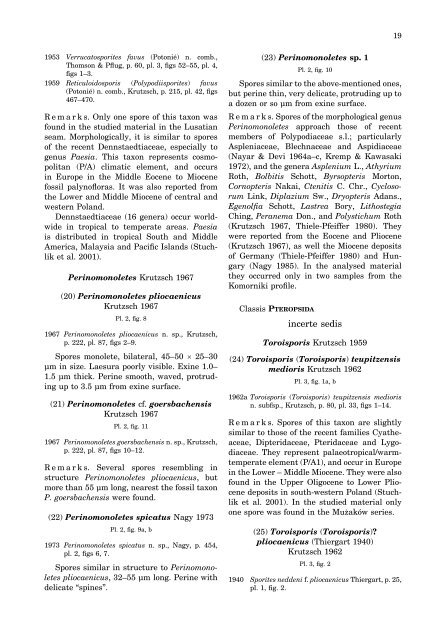Middle Miocene palynoflora of the Legnica lignite deposit complex ...
Middle Miocene palynoflora of the Legnica lignite deposit complex ...
Middle Miocene palynoflora of the Legnica lignite deposit complex ...
You also want an ePaper? Increase the reach of your titles
YUMPU automatically turns print PDFs into web optimized ePapers that Google loves.
1953 Verrucatosporites favus (Potonié) n. comb.,<br />
Thomson & Pfl ug, p. 60, pl. 3, fi gs 52–55, pl. 4,<br />
fi gs 1–3.<br />
1959 Reticuloidosporis (Polypodiisporites) favus<br />
(Potonié) n. comb., Krutzsch, p. 215, pl. 42, fi gs<br />
467–470.<br />
R e m a r k s. Only one spore <strong>of</strong> this taxon was<br />
found in <strong>the</strong> studied material in <strong>the</strong> Lusatian<br />
seam. Morphologically, it is similar to spores<br />
<strong>of</strong> <strong>the</strong> recent Dennstaedtiaceae, especially to<br />
genus Paesia. This taxon represents cosmopolitan<br />
(P/A) climatic element, and occurs<br />
in Europe in <strong>the</strong> <strong>Middle</strong> Eocene to <strong>Miocene</strong><br />
fossil palyn<strong>of</strong>l oras. It was also reported from<br />
<strong>the</strong> Lower and <strong>Middle</strong> <strong>Miocene</strong> <strong>of</strong> central and<br />
western Poland.<br />
Dennstaedtiaceae (16 genera) occur worldwide<br />
in tropical to temperate areas. Paesia<br />
is distributed in tropical South and <strong>Middle</strong><br />
America, Malaysia and Pacifi c Islands (Stuchlik<br />
et al. 2001).<br />
Perinomonoletes Krutzsch 1967<br />
(20) Perinomonoletes pliocaenicus<br />
Krutzsch 1967<br />
Pl. 2, fi g. 8<br />
1967 Perinomonoletes pliocaenicus n. sp., Krutzsch,<br />
p. 222, pl. 87, fi gs 2–9.<br />
Spores monolete, bilateral, 45–50 × 25–30<br />
μm in size. Laesura poorly visible. Exine 1.0–<br />
1.5 μm thick. Perine smooth, waved, protruding<br />
up to 3.5 μm from exine surface.<br />
(21) Perinomonoletes cf. goersbachensis<br />
Krutzsch 1967<br />
Pl. 2, fi g. 11<br />
1967 Perinomonoletes goersbachensis n. sp., Krutzsch,<br />
p. 222, pl. 87, fi gs 10–12.<br />
R e m a r k s. Several spores resembling in<br />
structure Perinomonoletes pliocaenicus, but<br />
more than 55 μm long, nearest <strong>the</strong> fossil taxon<br />
P. goersbachensis were found.<br />
(22) Perinomonoletes spicatus Nagy 1973<br />
Pl. 2, fi g. 9a, b<br />
1973 Perinomonoletes spicatus n. sp., Nagy, p. 454,<br />
pl. 2, fi gs 6, 7.<br />
Spores similar in structure to Perinomonoletes<br />
pliocaenicus, 32–55 μm long. Perine with<br />
delicate “spines”.<br />
(23) Perinomonoletes sp. 1<br />
Pl. 2, fi g. 10<br />
19<br />
Spores similar to <strong>the</strong> above-mentioned ones,<br />
but perine thin, very delicate, protruding up to<br />
a dozen or so μm from exine surface.<br />
R e m a r k s. Spores <strong>of</strong> <strong>the</strong> morphological genus<br />
Perinomonoletes approach those <strong>of</strong> recent<br />
members <strong>of</strong> Polypodiaceae s.l.; particularly<br />
Aspleniaceae, Blechnaceae and Aspidiaceae<br />
(Nayar & Devi 1964a–c, Kremp & Kawasaki<br />
1972), and <strong>the</strong> genera Asplenium L., Athyrium<br />
Roth, Bolbitis Schott, Byrsopteris Morton,<br />
Cornopteris Nakai, Ctenitis C. Chr., Cyclosorum<br />
Link, Diplazium Sw., Dryopteris Adans.,<br />
Egenolfi a Schott, Lastrea Bory, Lithostegia<br />
Ching, Peranema Don., and Polystichum Roth<br />
( Krutzsch 1967, Thiele-Pfeiffer 1980). They<br />
were reported from <strong>the</strong> Eocene and Pliocene<br />
(Krutzsch 1967), as well <strong>the</strong> <strong>Miocene</strong> <strong>deposit</strong>s<br />
<strong>of</strong> Germany (Thiele-Pfeiffer 1980) and Hungary<br />
(Nagy 1985). In <strong>the</strong> analysed material<br />
<strong>the</strong>y occurred only in two samples from <strong>the</strong><br />
Komorniki pr<strong>of</strong>i le.<br />
Classis PTEROPSIDA<br />
incerte sedis<br />
Toroisporis Krutzsch 1959<br />
(24) Toroisporis (Toroisporis) teupitzensis<br />
medioris Krutzsch 1962<br />
Pl. 3, fi g. 1a, b<br />
1962a Toroisporis (Toroisporis) teupitzensis medioris<br />
n. subfsp., Krutzsch, p. 80, pl. 33, fi gs 1–14.<br />
R e m a r k s. Spores <strong>of</strong> this taxon are slightly<br />
similar to those <strong>of</strong> <strong>the</strong> recent families Cya<strong>the</strong>aceae,<br />
Dipteridaceae, Pteridaceae and Lygodiaceae.<br />
They represent palaeotropical/warmtemperate<br />
element (P/A1), and occur in Europe<br />
in <strong>the</strong> Lower – <strong>Middle</strong> <strong>Miocene</strong>. They were also<br />
found in <strong>the</strong> Upper Oligocene to Lower Pliocene<br />
<strong>deposit</strong>s in south-western Poland (Stuchlik<br />
et al. 2001). In <strong>the</strong> studied material only<br />
one spore was found in <strong>the</strong> Mużaków series.<br />
(25) Toroisporis (Toroisporis)?<br />
pliocaenicus (Thiergart 1940)<br />
Krutzsch 1962<br />
Pl. 3, fi g. 2<br />
1940 Sporites neddeni f. pliocaenicus Thiergart, p. 25,<br />
pl. 1, fi g. 2.

















